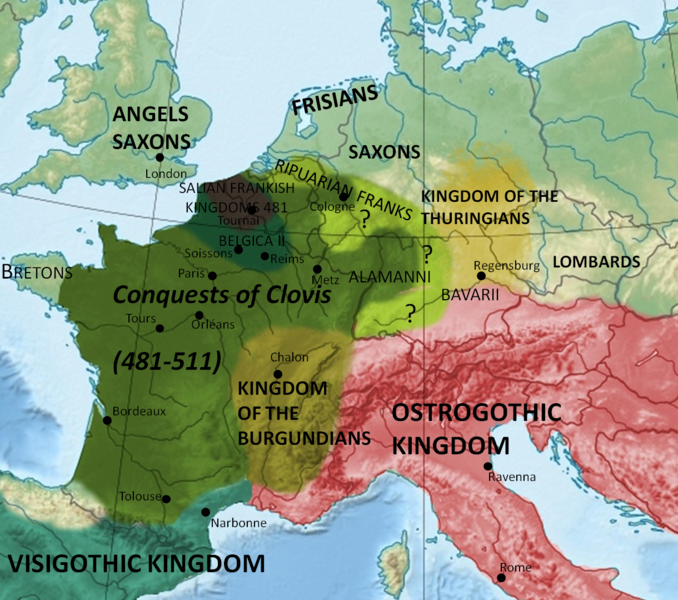The Franks were a Germanic tribe; their ancient homeland was located around the western part of the Baltic Sea and in northern Germany. The name “Franks” was used for the first time in the third century, for a group of Germanic tribes that was located between the Rhine and Weser River. The Franks were dived in three groups during this period: the Salian Franks, the Ripuarians and the Eastern Franks. The Salian Franks are mentioned as settlers on the lower Rhine. From the 4th century they pressured the borders which are roughly equivalent to the borders of Belgium and the Netherlands today. The Rupuarian Franks were settling on the middle Rhine, while the eastern Franks were inhabitants of the region that lies east of the Rupuarian Franks, German Franconia.
The first Franks that entered Roman territory were the Salian Franks. They were assigned to defend the Roman borders from other Germanic tribes around 350; the Salian Franks became Roman foederati. They were fighting alongside the Romans in the battle of the Catalaunian plains in 451; they were loyal to the Western Roman Empire until the fall of the empire. They established themselves in northern Gaul after 476, with the goal of inward expansion. The Franks would go on to form a state after this, and the advantage of that state, when directly compared to other Germanic states, was that their homeland was always incorporated in their territory.
Clovis I or Clodovech (481 – 511)
The Frankish state was formed under Clovis. Clovis was a descendent of the Merovingian dynasty. His grandfather was Merovech (448 – 458), the founder of the dynasty and the man who led the Frank forces in the battle of the Catalaunian plains. His son was Childeric I (458 – 581), who moved to Tournai, a town that lies on the border of France and Belgium today. Clovis succeeded his father as the commander of the Salian Franks in Tournai. The fall of the Roman Empire (476) was used by him to bolster his own strength. One of the first actions of Clovis political reign was the Frankish expansion into Gaul; that is, the territory which is located between the Seine and Loire Rivers, which was Roman at that time. In 486 Clovis I invaded Gaul and defeated the Roman troops. He extended his state to the Loire River, and moved his capital from Tournai to Parisii (Paris). Clovis established himself as the strongest leader of the Salian Franks. Clovis married Clotilde in 492, to strengthen his friendship with the Burgundians.
The war against the Alemanni (496)
Clovis faced the Alemanni threat. The Alemanni were a Germanic tribe which settled in the region of the northern Rhine. Around 406 the Alemanni, along with the Vandals, Suebi, Alans and Burgundians, crossed the frozen river into Gaul. They established themselves in the central and eastern parts of the region. Clovis attacked them in 496 to prevent them from further expansion. The defeated tribes were forced out of Gaul, the remaining Alemanni became servants of the Ostrogoth king Theodoric the Great (493 – 526).
The conversion of Franks to Christianity (496)
After the war with the Alemanni, Clovis converted to Christianity. As a Christian, he could count on the support of the Church, and the integration of the Galo-Roman and Frankish population would be a lot easier. Whatever his reasons, he was baptized in 496 by Remigius, the bishop of Reims, along with other Frankish leaders and 3000 other Franks.



What did the cooperation of the Franks and the Church look like after these times? The Church was wholeheartedly supporting all of the actions that Clovis took, and he granted fiefs and land to the church, built churches and supported the expansion of Christianity.
Clovis attacked the Visigoths in 507, in an attempt to expand his territory to the east of the Loire River. The official casus belli (a case of war) that Clovis used was that the Visigoths were Arian Christians, therefore heretics. The deceive battle was fought in 507 near Vouillé, the Franks prevailed and the Visigoth king, Alaric II was slain. Clovis conquered the entirety of Gaul, with the exception of Provance and Septimania, which were under the protection of the Ostrogoth king Theodoric. The eastern Roman emperor Anastasius I (491 -518) declared Clovis a consul, therefore practically legalizing his rule in Gaul. This was done out of fear, since Anastasius was an enemy of the Ostrogoths.
To further strengthen the bond between church and state, Clovis called a church council in Orleans in 511. Clovis codified the first laws which were regulating the legal state in his kingdom. He established the so called “personalization of law”. The codex of Alaric (Breviarium Alaricianum – 506) was used for the Gallo-Roman population, while the Franks were judged by customary law, which was codified in the Salian codex, the Lex Salicia.
